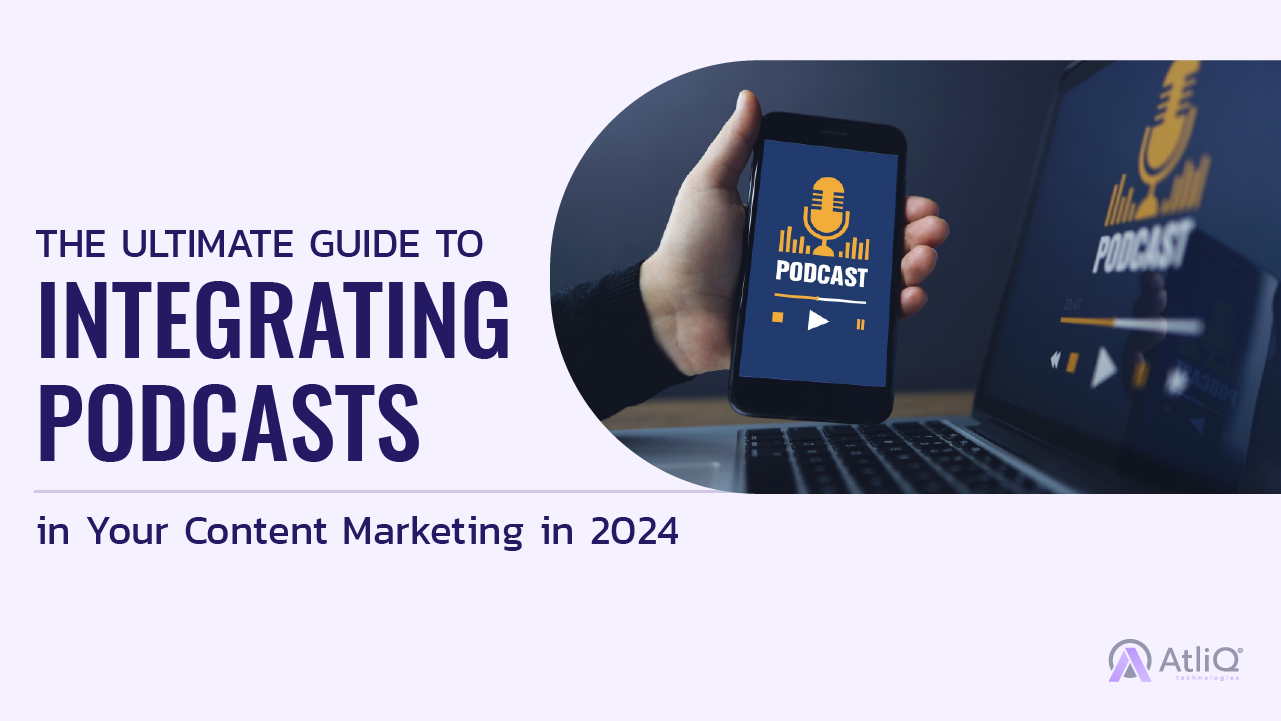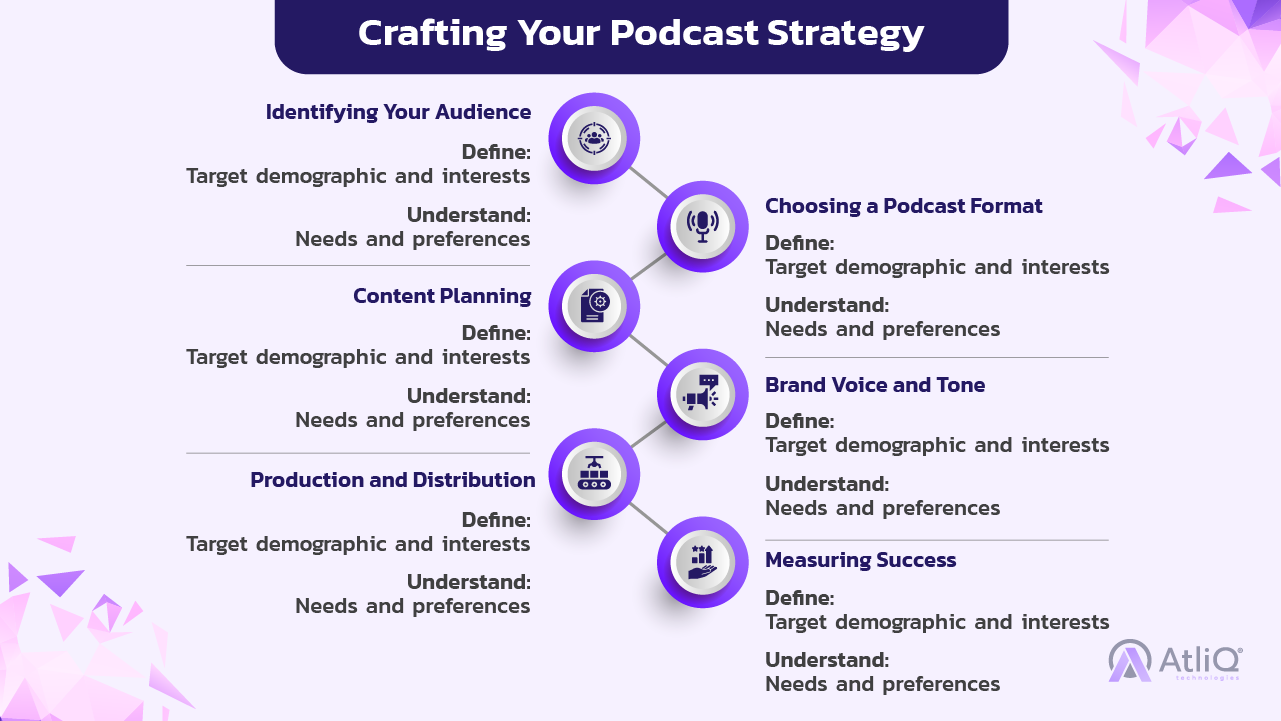
Podcasting isn’t just a trend—it’s a revolution in how we consume content.
Did you know that as of 2023, over 464.7 million people around the world are tuning into podcasts regularly? By 2024, this number is projected to exceed 500 million. This astonishing growth highlights an incredible opportunity for brands to tap into a thriving, engaged audience.
In today’s saturated content landscape, integrating podcasts into your content marketing strategy is a game-changer. Imagine reaching your audience while they commute, work out, or even cook dinner. Podcasts offer a unique, intimate connection that written or visual content can’t always achieve. They allow you to tell your brand’s story, share your expertise, and build trust in a way that’s personal and engaging.
Whether you’re a podcasting novice or looking to refine your existing efforts, this guide will equip you with everything you need to make podcasting a powerful pillar of your content marketing strategy. So, let’s dive in and discover the power of podcasting!
What is a Podcast?
A podcast is a series of spoken-word audio episodes that are typically focused on a particular topic or theme. They are often available for streaming or download through various platforms, allowing listeners to enjoy content on-demand. From storytelling and interviews to educational series and commentary, podcasts offer a versatile medium for delivering content.
Growth of Podcasting
The growth of podcasting has been nothing short of phenomenal. In 2018, there were about 550,000 active podcasts. By 2023, this number had surged to over 2 million, with more than 48 million episodes available to listeners. The convenience of on-demand listening, coupled with the diversity of content, has driven this rapid increase. Podcasts now cover an expansive range of genres, including true crime, business, health, entertainment, and more, catering to virtually every interest and niche.
Audience Engagement
One of the most compelling aspects of podcasting is the level of audience engagement it fosters. Unlike other forms of media, podcasts create a sense of intimacy and personal connection. Listeners often tune in during their daily routines, such as commuting, exercising, or relaxing at home. This consistent engagement builds a loyal audience who returns for each new episode. Moreover, the conversational and often unfiltered nature of podcasts helps to build trust and authenticity, further enhancing audience loyalty.
Market Potential
The market potential for brands in the podcasting space is vast and largely untapped. With millions of active listeners and a growing audience base, podcasts provide a unique opportunity for brands to reach their target audience in a less intrusive and more engaging manner. Advertising in podcasts is highly effective, with studies indicating that podcast listeners are more likely to remember and act on ads compared to traditional media. Additionally, creating branded podcasts can help companies establish thought leadership, build brand awareness, and foster a deeper connection with their audience.
Benefits of Integrating Podcasts into Your Marketing Plan
Enhanced Reach: Podcasts offer an unparalleled opportunity to reach a broader and more diverse audience. Unlike traditional content that requires visual attention, podcasts can be consumed on the go. This means your content can reach people during their commutes, workouts, or household chores. With over 464.7 million podcast listeners globally and this number steadily growing, podcasts enable you to tap into a vast pool of potential customers who might not have the time or inclination to engage with written or visual content.
Deeper Connection: One of the standout benefits of podcasting is the ability to forge a deeper, more personal connection with your audience. The nature of audio content allows for a conversational tone, making listeners feel like they are part of an intimate dialogue rather than being passive consumers. This personal touch helps build trust and loyalty, as listeners often feel a closer bond with the hosts they regularly tune into. Unlike reading an article or watching a video, listening to a podcast can feel like having a chat with a knowledgeable friend, enhancing the emotional connection with your brand.
Multi-Tasking Medium: In our fast-paced world, the ability to multitask is highly valued, and podcasts fit seamlessly into this lifestyle. Listeners can absorb content while driving, exercising, cooking, or even working, making podcasts a highly flexible and convenient medium. This multi-tasking capability means your audience can engage with your content without needing to carve out specific time slots, leading to higher consumption rates and increased exposure for your brand.
SEO Benefits: Podcasts can significantly boost your SEO efforts through show notes and transcripts. Show notes are summaries of each episode that often include keywords, links, and other relevant information, which search engines can index. This helps in improving your search engine rankings and driving organic traffic to your website. Transcripts of podcast episodes provide a rich source of keyword-dense content that can further enhance your SEO. By optimizing show notes and transcripts with targeted keywords, you can improve visibility and attract more visitors to your site, thus expanding your reach and potential customer base.
Incorporating podcasts into your marketing strategy not only diversifies your content portfolio but also leverages the unique advantages of audio content. By enhancing your reach, fostering deeper connections, offering multitasking convenience, and boosting SEO, podcasts can become a powerful tool in driving your brand’s growth and engagement.

Production and Distribution Of Your Podcast
Equipment and Software
To ensure high-quality podcast production, investing in the right equipment and software is crucial. Here are some essential tools:
- Microphone: A good quality microphone is non-negotiable. The Audio-Technica ATR2100x-USB and the Blue Yeti are popular choices for their clear sound and affordability.
- Headphones: Reliable headphones like the Sony MDR7506 will help you monitor audio quality during recording and editing.
- Audio Interface: If you’re using an XLR microphone, an audio interface like the Focusrite Scarlett 2i2 is essential for connecting your mic to your computer.
- Recording Software: Audacity is a free, user-friendly option, while Adobe Audition offers more advanced features for those willing to invest.
- Pop Filter: To reduce plosive sounds (like “p” and “b”), a pop filter is a small but important addition to your setup.
Editing and Post-Production
Editing is where your podcast truly comes to life. Here are some tips to enhance your sound quality and add engaging elements:
- Clean Up Audio: Use noise reduction tools to eliminate background noise and ensure clear audio. Both Audacity and Adobe Audition offer effective noise-reduction features.
- Edit for Flow: Cut out long pauses, filler words (like “um” and “uh”), and any mistakes to maintain a smooth and engaging flow.
- Add Music and Effects: Incorporate intro and outro music, as well as sound effects to make your podcast more dynamic. Sites like Epidemic Sound and AudioJungle offer a variety of music tracks and effects.
- Consistency: Maintain consistent audio levels throughout the episode to avoid jarring volume changes.
Publishing Platforms
Once your podcast is ready, you need to choose a hosting platform to distribute it. Here are some popular options:
- Spotify: One of the most popular platforms, offering a wide reach and easy integration with other services.
- Apple Podcasts: A major player in the podcasting world, it’s crucial for reaching a broad audience.
- Google Podcasts: Great for reaching Android users and integrating with Google’s ecosystem.
- Podbean: An all-in-one platform that provides hosting, distribution, and monetization options.
- Buzzsprout: User-friendly and offers excellent analytics to help track your podcast’s performance.
Distribution Channels
Promoting your podcast effectively ensures it reaches your target audience. Here are some strategies:
- Social Media: Share episodes on platforms like Twitter, Instagram, Facebook, and LinkedIn. Use audiograms (short audio clips with visual elements) to make your posts more engaging.
- Email Newsletters: Include podcast episodes in your email newsletters. Highlight key topics and invite subscribers to listen.
- Collaborations: Partner with other podcasters or influencers in your niche. Guest appearances and cross-promotion can help you reach new audiences.
- Podcast Directories: Submit your podcast to directories like Stitcher, TuneIn, and iHeartRadio to increase visibility.
- Website Integration: Embed episodes on your website and create blog posts that complement each episode. This not only boosts SEO but also offers additional content for your audience.
By following these production and distribution strategies, you can create a high-quality podcast that reaches and resonates with your target audience, enhancing your overall content marketing plan.

In conclusion, podcasting has emerged as a formidable force in the realm of content marketing, offering brands a unique opportunity to engage with audiences in a meaningful and impactful way. By integrating audio content into your marketing strategy, you not only expand your reach to a diverse and growing audience but also foster deeper connections and build trust through the intimate medium of storytelling.
Podcasts provide a platform for brands to showcase their expertise, share compelling stories, and connect with listeners on a personal level, unlike any other form of content. The ability to consume podcasts while multitasking makes them incredibly accessible, allowing you to reach people during their daily routines and activities.
As podcasting continues to evolve and grow, now is the time for brands to embrace this powerful medium and leverage its potential to strengthen their content marketing efforts. Whether you’re just starting or looking to enhance your existing strategy, integrating podcasts into your content mix can drive significant results, helping you to stand out in a competitive landscape and forge lasting connections with your audience.
So, start your podcasting journey today and unlock the transformative power of audio content in your content marketing plan. Your audience is waiting to hear from you—let your voice be heard through the power of podcasting.